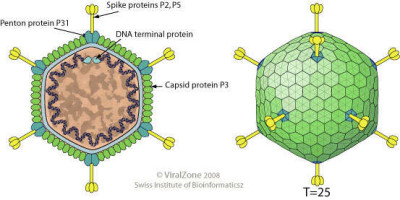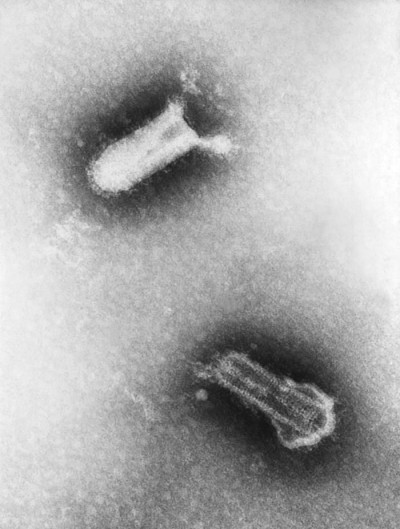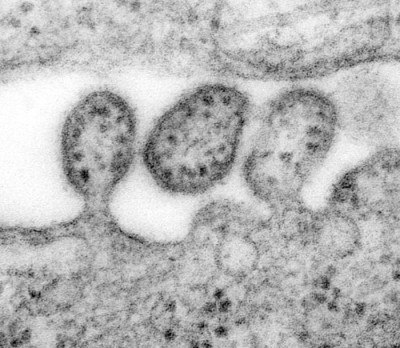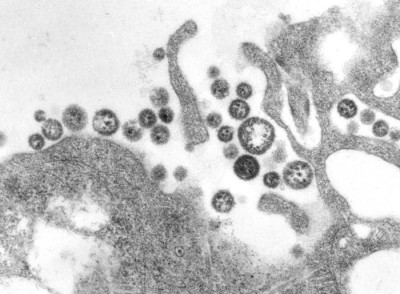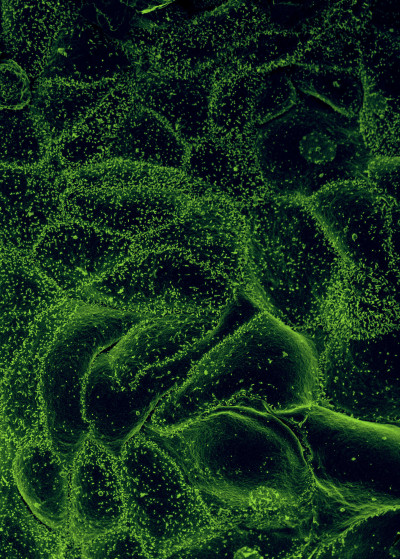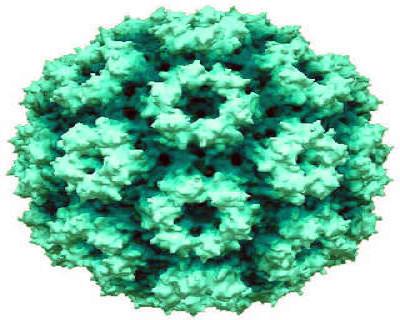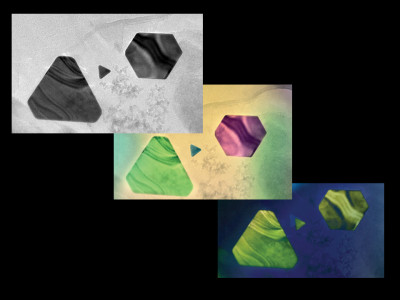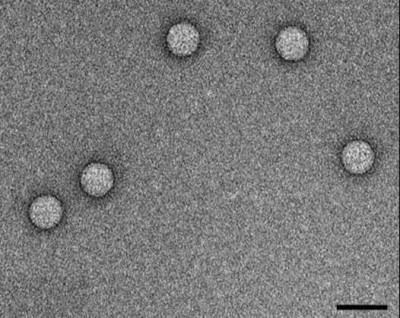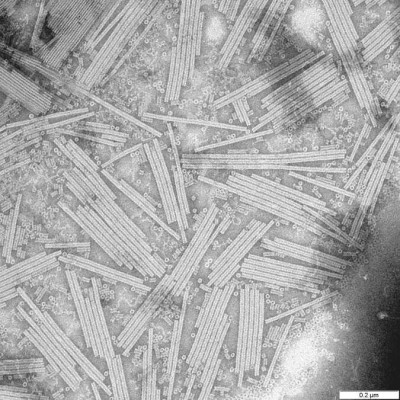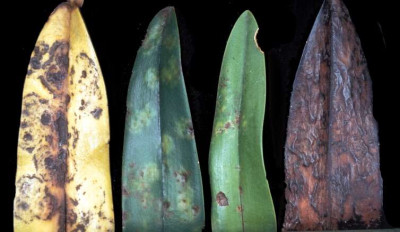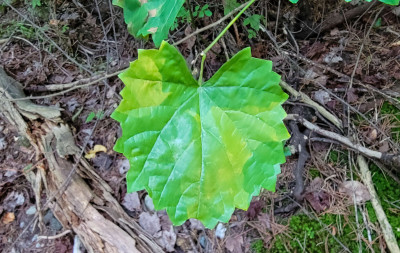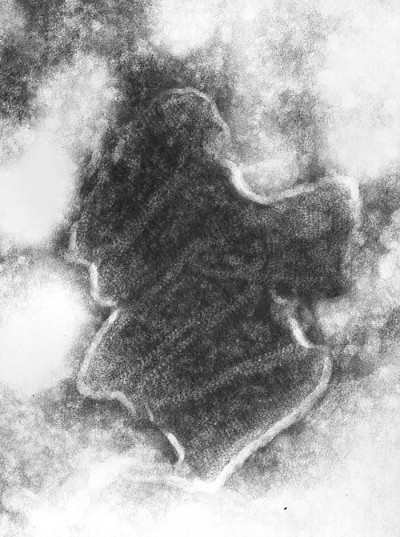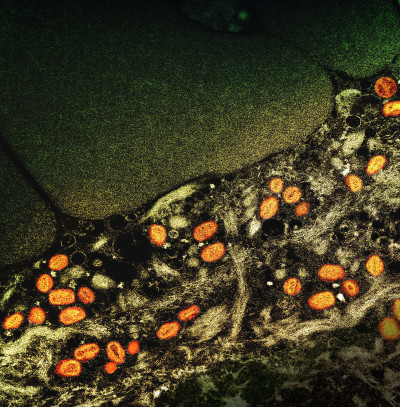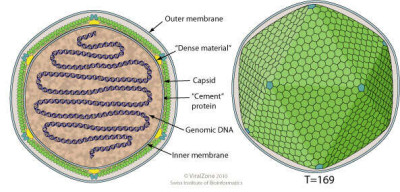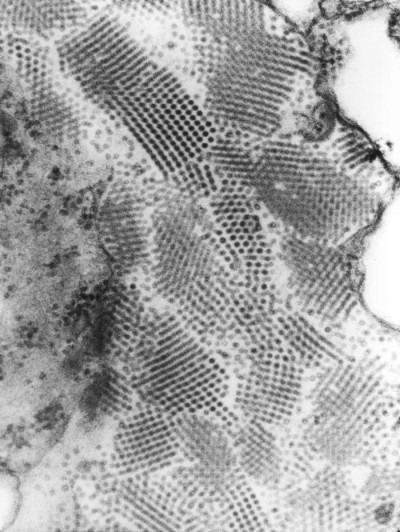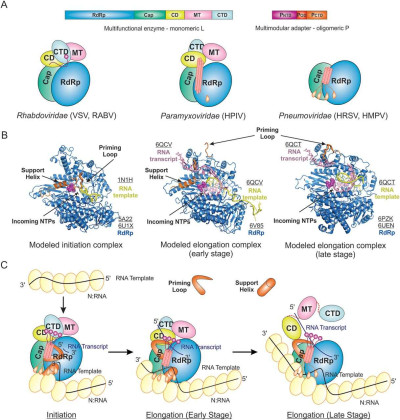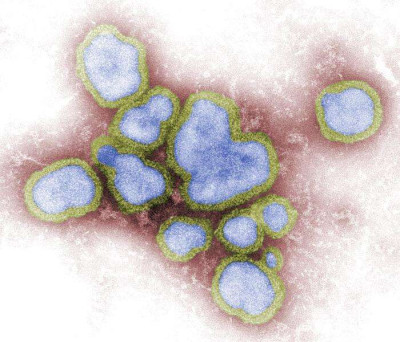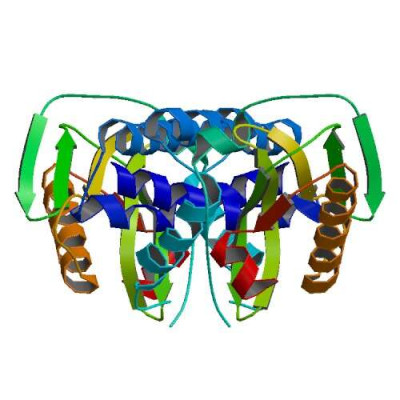Schematic drawing of a virion of the family Tectiviridae, cross section and external view.
ViralZone, SIB Swiss Institute of Bioinformatics, Wikimedia Commons
01 Mar 2024
This negatively-stained transmission electron micrograph (TEM) revealed the presence of two Piry virus virions. Note the bullet-like shape of the small 155nm x 162nm virions. Normally, under electron microscopic examination, the virions are observed as being discoidal or spheroidal in shape, and only rarely as bullet-shaped, as was the case here.
Public Health Image Library
16 Jan 2024
This highly magnified transmission electron micrograph (TEM) depicted some of the ultrastructural details of a number of Lassa virus virions adjacent to some cell debris. The virus, a member of the virus family Arenaviridae, is a single-stranded RNA virus, and is zoonotic, or animal-borne that can be transmitted to humans. The illness, which occurs in West Africa, was discovered in 1969 when two missionary nurses died in Nigeria, West Africa.
In areas of Africa where the disease is endemic (that is, constantly present), Lassa fever is a significant cause of morbidity and mortality. While Lassa fever is mild or has no observable symptoms in about 80% of people infected with the virus, the remaining 20% have a severe multisystem disease. Lassa fever is also associated with occasional epidemics, during which the case-fatality rate can reach 50%.
Public Health Image Library, C. S. Goldsmith
24 Jan 2024
This transmission electron micrograph (TEM) depicted numbers of Lassa virus virions adjacent to some cell debris. The virus, a member of the virus family Arenaviridae, is a single-stranded RNA virus, and is zoonotic, or animal-borne that can be transmitted to humans. The illness, which occurs in West Africa, was discovered in 1969 when two missionary nurses died in Nigeria, West Africa.
In areas of Africa where the disease is endemic (that is, constantly present), Lassa fever is a significant cause of morbidity and mortality. While Lassa fever is mild or has no observable symptoms in about 80% of people infected with the virus, the remaining 20% have a severe multisystem disease. Lassa fever is also associated with occasional epidemics, during which the case-fatality rate can reach 50%.
Public Health Image Library, C. S. Goldsmith
24 Jan 2024
Ebola virus isolated in November 2014 from patient blood samples obtained in Mali. The virus was isolated on Vero cells.
NIAID, Wikimedia Commons
24 Jan 2024
Belonging to the bromovirus genus, cowpea chlorotic mottle virus (CCMV) is a small spherical plant virus. Other members of this genus include the brome mosaic virus (BMV) and the broad bean mottle virus (BBMV).
Alan Cann, Wikimedia Commons
22 Feb 2024
Electron microscopy techniques (SEM and TEM) yield to greyscale micrographs. As a consequence, these microscopic images can be artificially colored by using common photo editors. Such possibility to differently color the regions of an electron micrograph represents a very useful potentiality. Indeed, the areas of the image can be variously colored and such ‘highlighting’ process can allow an easy/precise description of the picture contents. For example, the above image shows 2D-gold nanocrystals that have both hexagonal (see the purple particle) and pseudo-triangular (see the green particle) shapes [1]. In addition, microstructural features can be better evidenced by increasing contrast with an artificial coloration to them. For example, the interference frings generated by the TEM electronic beam interaction with the thin crystalline gold layer has been made clearly visible by increasing the contrast with a green coloration (see the color effect in the particles contained in the image at bottom). Further, nanostructures can be classified by coloring them with different colors, etc.
04 Mar 2024
Photograph of (Enterovirus 71) EV71 viral particles analyzed by transmission electron microscopy. The full particles had a solid structure with 33–35 nm in diameter. The bar indicates 50 nm.
Min-Yuan Chia, Wan-Yu Chung, Pai-Shan Chiang, Yeh-Sheng Chien, Mei-Shang Ho, and Min-Shi Lee, Wikimedia Commons
08 Mar 2024
Tobacco mosaic virus under magnification. Virus particles were purified by PEG/NaCl precipitation and sucrose cushion ultracentrifugation. Virus was then resuspended in 20 mM PO4 buffer, pH=7.2 to final concentration 10mg/ml. Formvar coated grids were floated on drops containing virus for 30 minutes, 3 times washed in deionised water and then stained with 2% PTA for 5 minutes.
Wikimedia Commons, Xmort
14 Mar 2024
Photo of orchid leaves with symptoms of tobacco mosaic virus.
Department of Plant Pathology , North Carolina State University, Bugwood.org, Wikimedia Commons
14 Mar 2024
Arabis Mosaic Virus (ArMV) is a plant virus that primarily infects members of the Brassicaceae family, including various species of Arabis (rockcress) and other cruciferous plants. Infected plants typically exhibit symptoms such as mosaic patterns on leaves, leaf discoloration (yellowing or mottling), stunted growth, and reduced vigor. The severity of symptoms can vary depending on factors such as the viral strain, host plant species, and environmental conditions.
iNaturalist
11 May 2024
This negatively-stained transmission electron micrograph (TEM) revealed the presence of numerous bovine ephemeral fever virus virions, which are members of the Rhabdoviridae family of viruses, and the genus Ephemerovirus, infecting animals as well as plants.
Public Health Image Library
17 Jan 2024
Colorized transmission electron micrograph of monkeypox particles (orange) found within an infected cell (brown), cultured in the laboratory. Image captured at the NIAID Integrated Research Facility (IRF) in Fort Detrick, Maryland.
Wikimedia Commons
09 Apr 2024
Architecture of electricity generation using microbial fuel cell (MFC).
10 Jan 2024
Enveloped virion of which the membrane is surrounded by a capsid with an icosahedral symmetry (T=169), 100-220 nm in diameter. Dense material are present at each 5-fold symmetry vertex.
ViralZone, SIB Swiss Institute of Bioinformatics
22 Jan 2024
This transmission electron micrograph (TEM) revealed the presence of numbers of Nodamura virus virions. At its core, the Nodamura virus possesses a positive-sense, single-stranded RNA virus ((+) ssRNA) genome. Its outer protein coat, or capsid, is icosahedral (T=3) in shape, which means that its composed of 32 equilateral, triangular facets.
Public Health Image Library
24 Jan 2024
(A) The cartoon diagrams of recently reported structures of the Rhabdoviridae (VSV and RABV), Paramyxoviridae (HPIV), and Pneumoviridae (HRSV and HMPV) polymerases. The same color scheme as Fig. 2. (B) The modeled initiation and elongation complexes. The RdRp domain of the L proteins of Rhabdoviridae (VSV), Paramyxoviridae (HPIV), and Pneumoviridae (HRSV) with modeled RNA template from reovirus λ3 polymerase (PDB: 1N1H), FluB polymerase (PDB: 6QCV), and FluB polymerase (PDB: 6QCT), respectively. The same color scheme for the RdRp domain of Mononegavirales L. The priming loop (from the Cap domain) and the support helix (from the RdRp domain) are colored in orange. The modeled RNA template and RNA transcript are shown in yellow and pink, respectively. (C) The proposed cartoon models of the initiation and elongation stages on the nucleoprotein (N) encapsidated N:RNA (NC) template. Initiation, the priming loop and support helix are at the close approximate of the GDN active site of the RdRp domain of L; elongation (early stage), the priming loop is away from but the support helix stays at the close approximate to the active site of the RdRp domain of L; elongation (late stage), the priming loop is away from the active site of the RdRp domain of L, the support helix is missing, and the CD, MT, and CTD domains of L are disordered and linked by dashed lines. The nucleoprotein (N) protein is shown as the yellow oval. The RNA template, RNA transcript, and the flexible linker are shown in the black, blue, and red lines, respectively. The priming loop and support helix are shown as the thick orange bar and cylinder, respectively. The PDB accession codes are underlined [1].
Wikimedia Commons, Bo Liang
25 Jan 2024
Electron micrograph of the Marburg virus. Marburg virus, first recognized in 1967, causes a severe type of hemorrhagic fever, which affects humans, as well as non-human primates.
Fred Murphy; J. Nakano, Centers for Disease Control and Prevention's Public Health Image Library (PHIL)
31 Jan 2024
This digitally-colorized, negative-stained transmission electron microscopic (TEM) image depicted a number of Influenza A virions.
Wikimedia Commons, F A Murphy
01 Feb 2024
Dimer of the Influenzavirus A non-structural protein 1 from A/Vietnam/1203/2004(H5N1) [1].
Wikimedia Commons, Zachary A. Bornholdt; B. V. Venkataram Prasad
02 Feb 2024
 Encyclopedia
Encyclopedia
